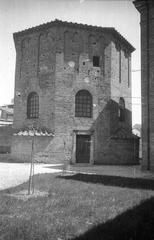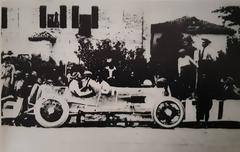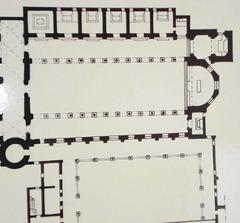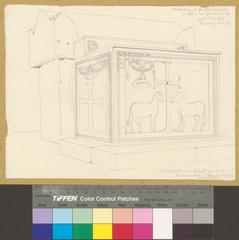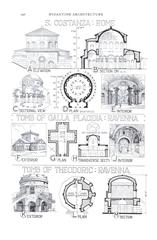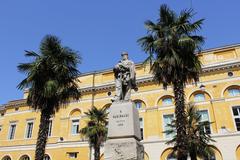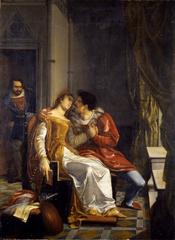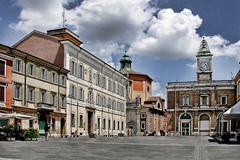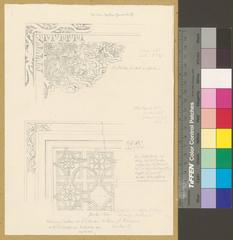Casa del Monte di Pietà, Ravenna, Italy: Visiting Hours, Tickets, and Historical Sites Guide
Date: 14/06/2025
Introduction
The Casa del Monte di Pietà, located in the heart of Ravenna, stands as a monument to Italy’s centuries-old tradition of ethical finance, charitable lending, and community support. Founded in the late 15th century by Franciscan friars to combat usury and offer low-interest loans to those in need, this institution has left a lasting imprint on Ravenna’s social and architectural landscape. Today, while the building itself is being redeveloped, the legacy of the Monte di Pietà continues to inspire visitors interested in history, culture, and the evolution of social welfare in Italy.
This guide provides a detailed overview of the Monte di Pietà’s history and significance, as well as current practical information for visitors, including accessibility, nearby attractions, and tips for making the most of your visit to Ravenna’s historic center.
Table of Contents
- Historical Overview and Cultural Significance
- Architectural Evolution and Features
- Planning Your Visit: Hours, Tickets, and Access
- Nearby Attractions and Suggested Itineraries
- Events, Research, and Educational Opportunities
- Visitor Tips and Practical Information
- Frequently Asked Questions (FAQ)
- Summary and Recommendations
- References and Further Resources
Historical Overview and Cultural Significance
Origins and Mission
The Casa del Monte di Pietà in Ravenna was established in 1492, part of a broader network of Italian “Monti di Pietà” that began in the mid-15th century. These institutions were created as a Christian response to usury, providing low-interest loans secured against personal belongings. The Franciscans, with support from local elites and civic authorities, championed this mission to protect the vulnerable, foster social justice, and promote community solidarity (Fondazione del Monte di Bologna e Ravenna).
Social Impact
Over the centuries, the Monte di Pietà became a cornerstone of Ravenna’s economic and social life. It offered financial support to artisans, widows, and the working poor, reinforcing values of charity, inclusion, and ethical conduct. Its archives, now held by the Fondazione del Monte di Bologna e Ravenna, provide a valuable window into the evolution of charitable lending and civic responsibility (archivissima.it).
Relationship to Broader Traditions
The Monte di Pietà’s operation reflects the interplay between religion, social welfare, and financial innovation in Renaissance Italy. It coexisted with other financial institutions, such as Jewish banks and later secular mutual aid societies, and became a model for ethical credit initiatives throughout Europe (Mons Pietatis portal).
Architectural Evolution and Features
The Casa del Monte di Pietà’s architecture tells the story of its growth and adaptation over time. Initially occupying the ground floor of a two-story building, the Monte expanded through donations and acquisitions, culminating in a unified structure with an elegant façade after major renovations in 1788. Restorations in the 20th century preserved signature elements such as wooden archival cabinets and period ceilings, reflecting Ravenna’s civic architectural style (Catalogo Beni Culturali; Mons Pietatis).
Currently, the building is undergoing redevelopment for mixed use, but its exterior remains a significant historic landmark in the city’s central district (Il Resto del Carlino).
Planning Your Visit: Hours, Tickets, and Access
Location
The Casa del Monte di Pietà is centrally situated on Via Diaz, within easy walking distance of Ravenna’s major historical sites, including the Basilica of San Vitale and the Arian Baptistery (Mapcarta).
Current Status and Visiting Hours
As of June 2025:
- The Casa del Monte di Pietà is closed to the public due to ongoing redevelopment.
- The building’s exterior is viewable at any time from Via Diaz; interior access is not currently possible (Il Resto del Carlino).
Archival Visits:
- Access to the Monte’s archival collections is available by appointment only through the Fondazione del Monte di Bologna e Ravenna (archives are located in Bologna). Advance booking is required, especially for researchers and scholars (Mons Pietatis portal).
Tickets and Guided Tours
- There is no fee to view the exterior of the building.
- Guided tours and exhibitions are occasionally organized by affiliated cultural foundations. Details are available on their official websites; participation may require registration or a ticket (Mons Pietatis portal).
Accessibility
- The area surrounding the Monte di Pietà is pedestrian-friendly, with smooth pavements.
- Some historic streets may have uneven surfaces; visitors with mobility issues should check local accessibility information before visiting (Edifici Storici Ravenna).
Nearby Attractions and Suggested Itineraries
Ravenna’s historical center is dense with UNESCO World Heritage sites, making it easy to combine a visit to the Casa del Monte di Pietà with other highlights:
- Arian Baptistery: Renowned for its early Christian mosaics (Mapcarta).
- Basilica of San Vitale: Famous for its Byzantine mosaics.
- Santa Maria del Suffragio: Notable nearby church.
- Piazza del Popolo: The city’s central square.
A recommended walking itinerary includes these sites, with a stop to appreciate the Monte di Pietà’s façade and architectural details along Via Diaz.
Events, Research, and Educational Opportunities
The Casa del Monte di Pietà is a focal point for historical research and public engagement on the history of ethical finance and social welfare. The Centro di studi sui Monti di Pietà e sul credito solidaristico hosts conferences, workshops, and exhibitions exploring the development of charitable institutions. Researchers and students can access specialized libraries and digital resources, enriching their understanding of social finance and local history (Mons Pietatis portal).
Visitor Tips and Practical Information
- Plan Ahead: Monitor official websites for updates on reopening, special events, or guided tours.
- Photography: Exterior photography is permitted and encouraged; interior photography is not possible during renovations.
- Best Times to Visit: Spring and early autumn offer pleasant weather and fewer crowds. Weekdays are less busy than weekends.
- Language: Italian is the main language, but English is spoken in tourist areas. Local tourist offices provide maps and assistance.
- Amenities: Once renovations are complete, retail shops will occupy the ground floor; in the meantime, the surrounding area offers cafés and restaurants.
- Accommodation: Ravenna offers a range of lodging options near the city center; booking ahead is recommended during high season.
Frequently Asked Questions (FAQ)
Q: Is the Casa del Monte di Pietà open to visitors?
A: As of June 2025, the building is closed to the public for redevelopment. The exterior remains viewable at any time.
Q: Are tickets or guided tours available?
A: No tickets are needed for exterior viewing. Occasional tours or exhibitions may be organized; check official websites for updates.
Q: Can I access the archives?
A: Archival visits are by appointment only through the Fondazione del Monte di Bologna e Ravenna.
Q: Is the site accessible for people with disabilities?
A: The surrounding district is pedestrian-friendly, but some surfaces may be uneven. Confirm accessibility for specific needs in advance.
Q: What are nearby sites to visit?
A: Major attractions include the Arian Baptistery, Basilica of San Vitale, and Santa Maria del Suffragio.
Summary and Recommendations
The Casa del Monte di Pietà is a testament to Ravenna’s enduring commitment to social justice and community welfare. While interior access is currently restricted due to redevelopment, the building’s façade and historical significance make it a worthwhile stop on any cultural itinerary in Ravenna. To further enrich your visit, explore the city’s many UNESCO sites and stay informed about future opportunities to access the Monte’s archives and exhibitions.
For the latest information on visiting hours, tickets, and events, consult the official resources listed below. Enhance your experience by downloading digital guides and following updates from local heritage foundations.
References and Further Resources
- Fondazione del Monte di Bologna e Ravenna Archives, 2022
- Mons Pietatis Portal, 2024
- Edifici Storici Ravenna Project, 2023
- Il Resto del Carlino, 2025, Article on Casa del Monte di Pietà Redevelopment
- Catalogo Beni Culturali, Architectural Heritage of Casa del Monte di Pietà
- European Traveler, 2024, Visiting Ravenna Historical Sites
- Mapcarta, Location and Maps for Casa del Monte di Pietà
For further updates, travel tips, and digital resources, consider downloading the Audiala app or visiting the official Ravenna tourism website.
